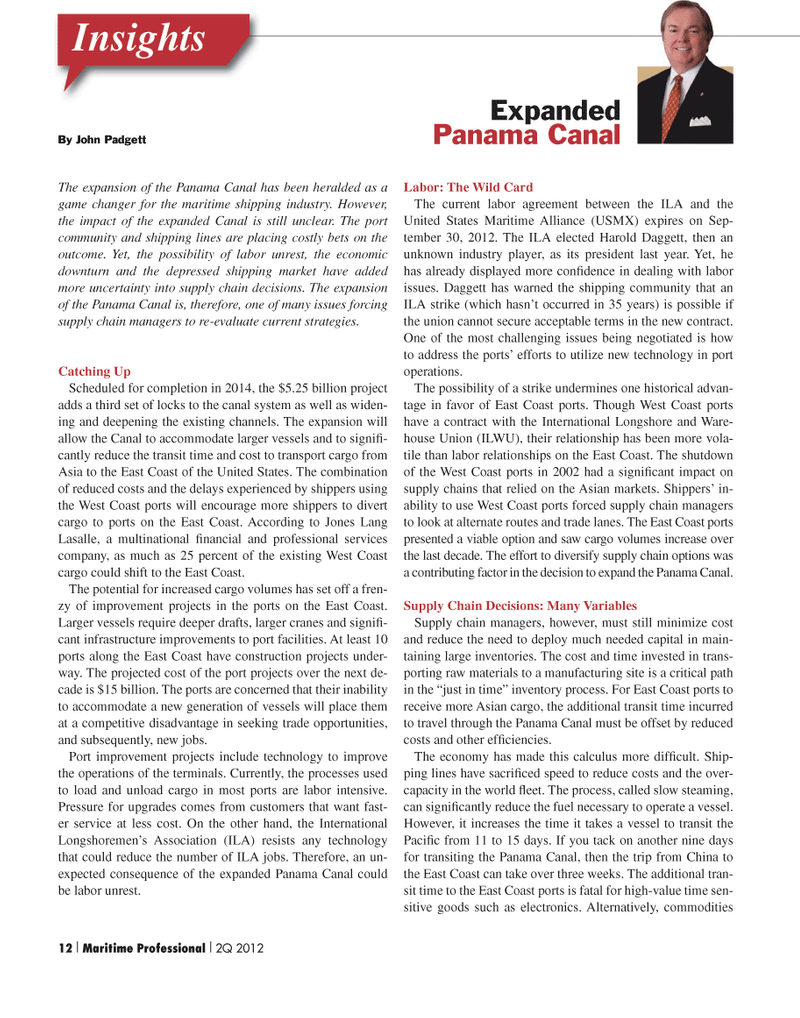
Page 12: of Maritime Logistics Professional Magazine (Q2 2012)
Maritime Risk
Read this page in Pdf, Flash or Html5 edition of Q2 2012 Maritime Logistics Professional Magazine
Insights
The expansion of the Panama Canal has been heralded as a game changer for the maritime shipping industry. However, the impact of the expanded Canal is still unclear. The port community and shipping lines are placing costly bets on the outcome. Yet, the possibility of labor unrest, the economic downturn and the depressed shipping market have added more uncertainty into supply chain decisions. The expansion of the Panama Canal is, therefore, one of many issues forcing supply chain managers to re-evaluate current strategies.
Catching Up
Scheduled for completion in 2014, the $5.25 billion project adds a third set of locks to the canal system as well as widen- ing and deepening the existing channels. The expansion will allow the Canal to accommodate larger vessels and to signifi - cantly reduce the transit time and cost to transport cargo from
Asia to the East Coast of the United States. The combination of reduced costs and the delays experienced by shippers using the West Coast ports will encourage more shippers to divert cargo to ports on the East Coast. According to Jones Lang
Lasalle, a multinational fi nancial and professional services company, as much as 25 percent of the existing West Coast cargo could shift to the East Coast.
The potential for increased cargo volumes has set off a fren- zy of improvement projects in the ports on the East Coast.
Larger vessels require deeper drafts, larger cranes and signifi - cant infrastructure improvements to port facilities. At least 10 ports along the East Coast have construction projects under- way. The projected cost of the port projects over the next de- cade is $15 billion. The ports are concerned that their inability to accommodate a new generation of vessels will place them at a competitive disadvantage in seeking trade opportunities, and subsequently, new jobs.
Port improvement projects include technology to improve the operations of the terminals. Currently, the processes used to load and unload cargo in most ports are labor intensive.
Pressure for upgrades comes from customers that want fast- er service at less cost. On the other hand, the International
Longshoremen’s Association (ILA) resists any technology that could reduce the number of ILA jobs. Therefore, an un- expected consequence of the expanded Panama Canal could be labor unrest.
Labor: The Wild Card
The current labor agreement between the ILA and the
United States Maritime Alliance (USMX) expires on Sep- tember 30, 2012. The ILA elected Harold Daggett, then an unknown industry player, as its president last year. Yet, he has already displayed more confi dence in dealing with labor issues. Daggett has warned the shipping community that an
ILA strike (which hasn’t occurred in 35 years) is possible if the union cannot secure acceptable terms in the new contract.
One of the most challenging issues being negotiated is how to address the ports’ efforts to utilize new technology in port operations.
The possibility of a strike undermines one historical advan- tage in favor of East Coast ports. Though West Coast ports have a contract with the International Longshore and Ware- house Union (ILWU), their relationship has been more vola- tile than labor relationships on the East Coast. The shutdown of the West Coast ports in 2002 had a signifi cant impact on supply chains that relied on the Asian markets. Shippers’ in- ability to use West Coast ports forced supply chain managers to look at alternate routes and trade lanes. The East Coast ports presented a viable option and saw cargo volumes increase over the last decade. The effort to diversify supply chain options was a contributing factor in the decision to expand the Panama Canal.
Supply Chain Decisions: Many Variables
Supply chain managers, however, must still minimize cost and reduce the need to deploy much needed capital in main- taining large inventories. The cost and time invested in trans- porting raw materials to a manufacturing site is a critical path in the “just in time” inventory process. For East Coast ports to receive more Asian cargo, the additional transit time incurred to travel through the Panama Canal must be offset by reduced costs and other effi ciencies.
The economy has made this calculus more diffi cult. Ship- ping lines have sacrifi ced speed to reduce costs and the over- capacity in the world fl eet. The process, called slow steaming, can signifi cantly reduce the fuel necessary to operate a vessel.
However, it increases the time it takes a vessel to transit the
Pacifi c from 11 to 15 days. If you tack on another nine days for transiting the Panama Canal, then the trip from China to the East Coast can take over three weeks. The additional tran- sit time to the East Coast ports is fatal for high-value time sen- sitive goods such as electronics. Alternatively, commodities Expanded
Panama CanalBy John Padgett 12 I Maritime Professional I 2Q 2012
MP #2 1-17NEW STYLES.indd 12 5/4/2012 4:52:50 PM

 11
11

 13
13
